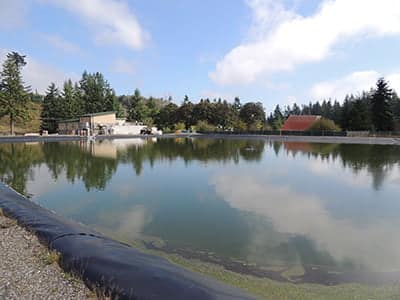Wastewater treatment is a process in which wastewater is changed into clean water that can then be put back into the environment. The main purpose of wastewater treatment is to ensure any solids and pollutants are removed from the water before it is put back into the environment. In doing so, we are keeping both our environment and ourselves clean.
 Commercial wastewater occupies its own strange space between residential wastewater and industrial wastewater. While the mixture of residential wastewater may vary from house to house and neighborhood to neighborhood, the basic sources are the same: toilets, sinks, bathtubs and showers, laundry equipment, and kitchen sinks and dishwashers. And industrial wastewater varies from location to location based on both scale and chemical make-up. But commercial wastewater is just different. The primary source of wastewater from an office park might be restrooms, while a high school's wastewater would include waste from locker rooms and a lunchroom along with restrooms. And a restaurant or an auto mechanics shop will turn those kinds of ratios sideways in still other directions. So, is there a way to conceive of commercial wastewater as a unified, if not uniform, entity, so it can be treated effectively, and even reused? Yes, yes there is.
Commercial wastewater occupies its own strange space between residential wastewater and industrial wastewater. While the mixture of residential wastewater may vary from house to house and neighborhood to neighborhood, the basic sources are the same: toilets, sinks, bathtubs and showers, laundry equipment, and kitchen sinks and dishwashers. And industrial wastewater varies from location to location based on both scale and chemical make-up. But commercial wastewater is just different. The primary source of wastewater from an office park might be restrooms, while a high school's wastewater would include waste from locker rooms and a lunchroom along with restrooms. And a restaurant or an auto mechanics shop will turn those kinds of ratios sideways in still other directions. So, is there a way to conceive of commercial wastewater as a unified, if not uniform, entity, so it can be treated effectively, and even reused? Yes, yes there is.
As stated above, commercial wastewater comes from non-domestic sources. Some perfect examples of non-domestic sources are places like beauty salons or auto body repair shops. The main distinction with this type of wastewater is that it often contains hazardous materials that require special treatment or disposal.
For all of the possible differences in the contents and volume of commercial wastewater, 99.9% of wastewater is just that: water. It's the waste making up the 0.1% that causes problems. Organic materials, infectious viruses & bacteria, oils, microplastics and potentially poisonous non-organic compounds are all among the regular contaminants of commercial wastewater. Where individual industrial water users can customize their wastewater treatment to the specific contaminants remaining from their processes, commercial wastewater treatment has to be a bit more generalized, because the contaminants are not constant. So the wastewater treatment systems and methods have to account for the anticipated variety of waste types.
Manual physical filtration and separation are the first and somewhat easiest steps in commercial wastewater treatment. A series of screens with increasingly-smaller grids set in forced-flow allows for the removal of all but the smallest foreign objects, while settling pools, skimmers, and/or oil-water separators can remove fats, oils, and greases (affectionately referred to as FOG). "How many filter screens are needed," "how much skimming is necessary," and "can a settling pond provide effective passive physical filtration and FOG removal efficiently," are questions that have to be asked and answered on a case-by-case basis. That way the wastewater treatment system can be designed with the specifics of the wastewater generators in mind.
Some of the options for treating the remaining wastewater include microbes with oxygen, microbes without oxygen, chemicals, and UV light. "[A]erobic digestion ... enables microscopic living organisms to transform wastewater into a clear, odorless liquid." Aerobic systems use oxygen to foster the growth of microbes, usually requiring mechanical mixing for maximum oxygen-biomass interaction; anaerobic systems, on the other hand, do not use oxygen, preventing all the fun odors of the accumulated biomass from escaping into the local environment. By direct comparison, aerobic systems are generally cheaper to build and can process more wastewater in a given amount of time, but the necessity of mechanical mixing means aerobic systems have higher energy requirements and thus higher on-going operational costs.
Routing wastewater through multiple treatment systems sequentially makes the most sense, both monetarily and spatially, for large wastewater treatment plants. Smaller, isolated plants can often make do with only one or two treatment types. The more thoroughly wastewater is treated, the more uses it can have, from sub-surface landscape irrigation for minimally treated wastewater, up to vehicle washing or fire hydrant supply for water treated to nearly-potable standards. Possible uses depend on local regulations. If treated wastewater uses that constitute full human-contact are not permitted, it doesn't make sense to treat commercial wastewater up to that standard.
No matter how you are treating commercial wastewater, no matter how many processes you are using, your system will need measurement instruments and control systems. Whether it's heavy duty continuous float level transmitters in tanks or ponds with sludge, float switches to control pumps, or even ultrasonic or radar level transmitters for water level monitoring, point level detection and continuous level monitoring are important parts of the commercial wastewater treatment process.
Whether you operate a commercial wastewater treatment system and are looking for new or replacement sensors, or you are an OEM looking for level and pressure sensors for the systems you build for your customers, APG's Measurement Experts can help you find the sensors and switches that will best meet your needs. Give them a call, send them an email, or live chat with them right now!
top photo credit: Eric Shea via flickr.com Creative Commons 2.0